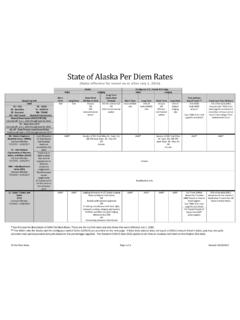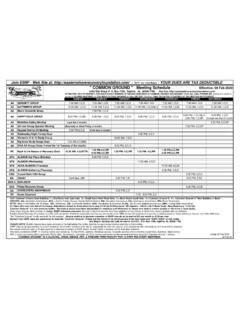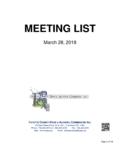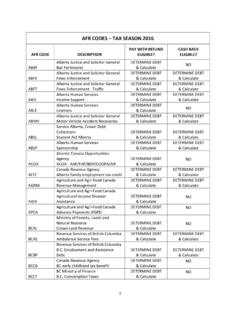Transcription of Addiction 101: A disease affecting both patient and family
1 " Addiction 101: a disease affecting both patient and family ". J. Randle Adair, , Diplomate, American Board of Internal Medicine Diplomate, American Board of Addiction Medicine Addiction : The History Addiction : The History Genesis 9: 20-25. Noah, a tiller of the soil, was the first to plant the vine. He drank some of the wine, and while he was drunk, he uncovered himself inside his tent. Ham, Canaan's ancestor, saw his father's nakedness, and told his two brothers outside. Shem and Japheth took a cloak and they both put it over their shoulders, and walking backward, covered their father's nakedness. When Noah awoke from his stupor he learned what his youngest son had done to him, and he said: Accursed be Canaan. He shall be his brothers'. meanest slave.
2 History of Chemical Dependency In 1849, the Swedish Physician Magnus Huss (1807-1890) was the first to systematically classify the damage that was attributable to alcohol ingestion. Huss coined the term alcoholism and used it to label what he considered to be a chronic, relapsing disease . History of Chemical Dependency In 1784, Dr. Benjamin Rush published an Inquiry into the Effects of Ardent Spirits on the Human Mind and Body which help launch the American temperance movement. He catalogued the symptoms of acute and chronic drunkenness, described progression, and suggested that chronic drunkenness was a disease induced by a vice.. History of Chemical Dependency Jellinek coined the expression "the disease concept of alcoholism" and significantly accelerated the movement towards the medicalization of drunkenness and alcohol habituation.
3 -1946. RIP: Bunky Jellinek Elvin Morton "Bunky" Jellinek (1890- 1963), E. Morton Jellinek, or most often, E. M. Jellinek, was a biostatistician, physiologist, and an alcoholism researcher. He was born in New York City and died at the desk of his study at Stanford University on 22. October 1963. Jellinek's Criteria (1960). Alpha alcoholism: the earliest stage of the disease , manifesting the purely psychological continual dependence on the effects of alcohol to relieve bodily or emotional pain. This is the "problem drinker", whose drinking creates social and personal problems. Whilst there are significant social and personal problems, these people can stop if they really want to; thus, argued Jellinek, they have not lost control, and as a consequence, do not have a " disease ".
4 Beta alcoholism: polyneuropathy, or cirrhosis of the liver from alcohol without physical or psychological dependence. These are the heavy drinkers that drink a lot, almost every day. They do not have physical Addiction and do not suffer withdrawal symptoms. This group do not have a " disease ". Gamma alcoholism: involving acquired tissue tolerance, physical dependence, and loss of control. This is the AA alcoholic, who is very much out of control, and does, by Jellinek's classification, have a " disease ". Delta alcoholism: as in Gamma alcoholism, but with inability to abstain, instead of loss of control. Epsilon alcoholism: the most advanced stage of the disease , manifesting as dipsomania, or periodic alcoholism. Jellinek's Criteria (1960). Jellinek's 1960 magnum opus in fact tries to limit the scope of the " disease concept", stating that most of the types described might be alcoholics, but they are not diseased.
5 Because they do not suffer from "loss of control". History of Chemical Dependency Jellinek's initial 1946 study was funded by Marty Mann and R. Brinkley Smithers. It was based on a narrow, selective study of a hand-picked group of members of Alcoholics Anonymous (AA) who had returned a self-reporting questionnaire. (Valverde opines that a biostatistician of Jellinek's eminence would have been only too well aware of the "unscientific status" of the "dubiously scientific data that had been collected by AA members".). Jellinek Curve 1980s History of Chemical Dependency 1951: The Lasker Award The American Public Health Association presents ..to Alcoholics Anonymous in recognition of its unique and highly successful approach to that age-old public health and social problem, alcoholism.
6 In emphasizing alcoholism as an illness . p. 571, BBAA, 4th edition Definition of Alcoholism Alcoholism is a primary, chronic disease with genetic, psychosocial, and environmental factors influencing its development and manifestations. The disease is often progressive and fatal. It is characterized by continuous or periodic: Impaired control over drinking, preoccupation with the drug alcohol, use of alcohol despite adverse consequences, and distortions in thinking, most notably denial.. American Society of Addiction Medicine/NCADD (1992). ASAM Definition of Addiction 2011. Addiction is a primary, chronic disease of brain reward, motivation, memory and related circuitry. Dysfunction in these circuits leads to characteristic biological, psychological, social and spiritual manifestations.
7 This is reflected in an individual pathologically pursuing reward and/or relief by substance use and other behaviors. Addiction is characterized by inability to consistently abstain, impairment in behavioral control, craving, diminished recognition of significant problems with one's behaviors and interpersonal relationships, and a dysfunctional emotional response. Like other chronic diseases, Addiction often involves cycles of relapse and remission. Without treatment or engagement in recovery activities, Addiction is progressive and can result in disability or premature death. Addiction : The Neurobiology Neural Reward Circuits Important in the Reinforcing Effects of Drugs of Abuse Cam , J. et al. N Engl J Med 2003;349:975-986. Addiction : The Genetics Addiction : The Genetics The first adoption-study evidence for an important genetic contribution to alcoholism risk was produced in Scandinavia.
8 In Copenhagen, Denmark, Goodwin and colleagues (1973, 1974, 1977) used official registries to identify biological parents who had histories of alcoholism and who had given up a child for early adoption by nonrelatives. Addiction : The Genetics Results: Rates of alcoholism were significantly elevated in both the adopted and nonadopted sons of alcoholics, results which were consistent with a genetic influence on alcoholism risk in men. Results for women were not significant. (Found to be statistically significant in other, later studies). First controlled scientific studies to separate out social vs. genetic, nature vs. nuture . Known cellular, genetic markers with behavioral correlates Serotonin Transporter Gene (SLC6A4): Chromosome DRD2 receptor: Chromosome 11q22-q23.
9 Alcohol-induced hypothermia, consumption, amphetamine, morphine responses: Chromosome 9 (5-HT-1B). Susceptibility to effects of cocaine Chromosome 11p (DRD4). Opioid effects Chromosome 2 (opioid receptor). Flushing, initial serum load of alcohol, male vs. female differences, brain wave oscillations Chromosome 4q (alcohol dehydrogenase). Effects of alcohol, BZ, barbiturates Chromosome 4p (GABA-A, GABA- 1). Chromosome 15 (GABA- 3). Serotonin level Chromosome 11 (tyrosine hydroxylase). Severity of Alcoholism Chromosome 16. Breaking news from the Human Genome DNA regions with susceptibility genes: Chromosomes 1, 2, 7. DNA regions with protective genes: Chromosome 4. DNA regions affecting co-morbid depression: Chromosome 7. Depression alone Chromosome 2.
10 DNA regions affecting P300 electrophysiology: Chromosomes 2, 5, 6, 13. For further information from the Human Genome, see The Collaborative Study on the Genetics of Alcoholism (COGA): Addiction : The family Families in Stress Their problems Their feelings Their defenses Their self-worth Their behavior Their communication Their recovery program Families in Stress: Their Problems Non-Alcoholic Alcoholic Identifiable know the Denied members show source of their distress or at sincere delusion. Alcohol least admit it when the has nothing to do with it.. source is brought to their attention. Families in Stress: Their Feelings Non-Alcoholic Alcoholic Painful, unexpressed and Acutely painful and totally may be repressed out of awareness part of a larger pattern of denial and delusion.







